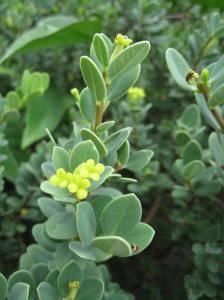Native Plants of Hawaii
Urban Shrubs
Hawaiian Rockwort
Scientific Name: Nototrichium sandwicense
This native plant has silvery leaves and is very popular among landscapers. This plant is drought resistant so it’s good for those looking to create a xeriscaping garden. The Hawaiians packed the flowers and wood of this plant in bamboo and would toss it over a cliff to create something similar to a firework display.
Ti
*Polynesian Introduced
Scientific Name: Cordyline terminalis
Hawaiian Names: Ki, Ti
This plant was another introduction by the Hawaiians to Hawaii. They used the Ti plant had a wide range of uses, ranging from, wrappings for food, thatching, medical purposes, plates, and clothes. The plant also was considered sacred to the god of agriculture ( Lono) and the godess of hula (Laka). An incredible demonstration of the use as a rain coat can be found here.
Forest gardenia
Scientific Name: Gardenia Brighamii
Hawaiian Name: Nanu, Na u
This is another popular easy to grow landscaping plant. However, it has become extremely difficult to find in the wild and has been listed on the federally endangered list. The Hawaiians used the pulp of this flower for a rich yellow dye reserved for chiefs.
Hawaiian Cotton
Scientific Name: Gossypium Tomentosum
Hawaiian Name: Ma’o Huluhulu
These shrubs have large hibiscus like flowers, but produce relatively short cotton fibers that were not useful for cordage or cooking. However the hairs were used for tinder and used similarly to a cotton swab or Q tip. The plant is also resistant to many pests and disease of commercial cotton and has been cross bread with commercial types to create disease resistant hybrids( Image by Forest and Starr Kim)
Hawaiian Rose
Scientific name: Ostemoeles Anthyllidifolia 
Hawaiian name: Ulei, Eluehe
This is an excellent xeroscape plant and a common problem is overwatering. The wood is extremely flexible and springy and was used for spears, and creating hoops. A little known fact is that Hawaiians used bows and arrows to hunt birds and rats. This springy wood was a choice selection for both the Hawaiians’ bows and arrows. The fruit is edible although it’s grainy and not very tasty.
Native Yellow Hibiscus
* Endangered
Scientific name: Hibiscus brackenridgei
Hawaiian name: Aloalo, Maʻo hau hele
This is the official Hibiscus flower of Hawaii. It’s fitting that this hibiscus is endangered when considering the vast number of endangered Native Hawaiian plants. The flowers’ pedals and stigma are yellow with either a solid or splotchy red center. This plant should not be confused with the much more common chinese hibiscus.
False Ohelo
Scientific name: Wikstroemia uva-ursi
Hawaiian name: Akia, Kauhi
There are 12 native varieties of this plant that originated from a single colonist. These 12 varieties formed distinct niches, occupying, rocky coasts, lava fields, dry forests, and wet forests. The most common type used for landscaping is Wikstroemia uva-ursi. This plant was used by the Hawaiians for cordage and certain types have a poison that stun fish, but leaves fish safe for consumption.
Hawaiian Hopseed Bush
Scientific name: Dodonaea Viscosa
Hawaiian name: Kumakani, A’Alii
Hawaiians used this tough wood for framework of houyses and for spears and weapons. This plant requires little water and lives in a wide range of altitudes and conditions. The varying colors of it’s seed caples were used for dying kapa. Interstingly the plants are unisex can produce both male and female flowers.
False Sandal Wood
Scientific Name: Myoporum Sandwicense
Hawaiian name: Naio
In the 1800’s this plant was sold as sandal wood due to it’s sharp and similar odor to the prized furniture wood. However, this ploy of using the Naio was soon discovered by importers and further imports were rejected. Thus the Naio earned the nickname of False sandal wood and Bastard Sandal Wood. Depending on its location and environment this plant can take many forms. Sometimes it crawls along the ground and at other times it sprouts up to 40ft tall trees.
Beach Naupaka
 Scientific name: Scaevola sericea
Scientific name: Scaevola sericea
Hawaiian name: Naupaka kahakai
Commonly known as the Beach Naupaka, this hardy plant can survive in harsh dry sunny conditions. The Naupaka’s white seeds can float for months in salt water. One study even suggested that the Beach Naupaka germinates best after 250 days in salt water. The Hawaiian legend about this unique 1/2 flower shape can be seen here. Modern day Snorkelers often crack the leaves open and rub the juice on their googles to prevent fogging



 Malama Hawaii
Malama Hawaii Preserve Hawaii
Preserve Hawaii Sierra Club
Sierra Club Volunteer Hawaii
Volunteer Hawaii East Maui Watershed Information
East Maui Watershed Information Hawaii Association of watershed Partnership
Hawaii Association of watershed Partnership Last Stand
Last Stand Native Plants Hawaii
Native Plants Hawaii Watershed Protection and Management Program
Watershed Protection and Management Program